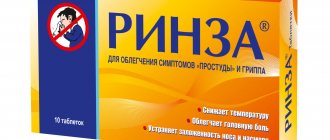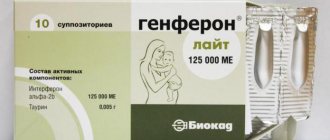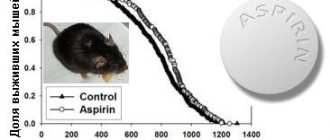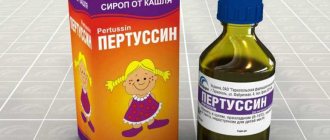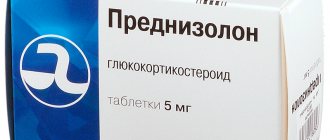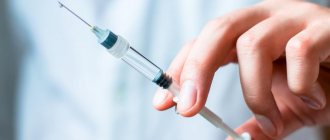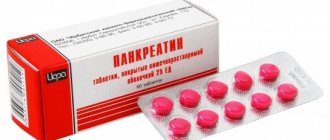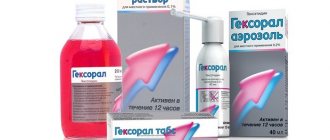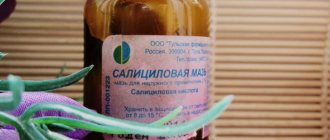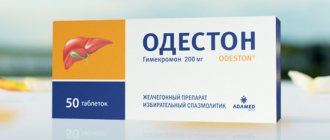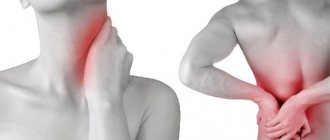Release form and composition
The drug is sold in the form of film-coated tablets.
| Pills | 1 tab. |
| paracetamol | 325 mg |
| naproxen | 100 mg |
| caffeine anhydrous | 50 mg |
| drotaverine hydrochloride | 40 mg |
| pheniramine maleate | 10 mg |
| Auxiliary components: microcrystalline cellulose, potato starch, croscarmellose sodium, hyprolose (hydroxypropylcellulose), citric acid monohydrate, butylhydrocentoluene (E321), magnesium stearate, talc, quinoline yellow dye (E 104), indigo carmine (E132). Film shell: hypromellose (hydroxypropyl methylcellulose), povidone (medium molecular weight PVP, povidone K25), polysorbate 80 (Tween 80), titanium dioxide, talc, quinoline yellow dye (E104), indigo carmine (E132). Mli shell Opadry 13A210001 green (Opadry 13A210001 Green): (hypromellose, povidone, polysorbate 80, titanium dioxide, talc, quinoline yellow, FD&C blue #2/indigo carmine). |
Side effects
Like other medications, pentalgin, in addition to its main effect, can also have other, less pleasant effects. Pentalgin contains caffeine and codeine - substances that can cause addiction to the body .
Side effects from taking the medication may include the following:
- nausea, vomiting, abdominal pain, with long-term use - ulcerative processes;
- increased blood pressure, heartbeat disturbances;
- unreasonable anxiety, sleep disturbances, headaches and dizziness, lack of attention;
- hearing loss, tinnitus;
- skin manifestations in the form of itching and rash;
- respiratory dysfunction.
Usually, all of the above manifestations pass quite quickly, without causing the patient severe discomfort. If the symptoms begin to intensify, you should consult a doctor.
An overdose of pentalgin is possible if you do not carefully study the instructions or ignore the recommendations of your doctor . To avoid unpleasant consequences, you should follow the dose and frequency of administration, and also carefully monitor the degree of adverse reactions.
Substitute drugs
Like any other medicine, the medicine has generics. Analogs of "Pentalgin" in tablets:
- "Plivalgin."
- "Pentalffen."
- "Sedalgin."
- "Pentamyalgin."
Some medications contain narcotic analgesics, so they are sold in pharmacies only with a prescription.
"Sedalgin" is a non-steroidal anti-inflammatory drug used to symptomatically reduce pain, as well as to reduce elevated body temperature. The cost of the drug is 180 rubles. The drug is available in tablet form and contains the following microelements:
- caffeine;
- metamizole sodium;
- Thiamine hydrochloride.
"Sedalgin" has an analgesic, anti-inflammatory therapeutic effect. Substances are distributed evenly throughout the human body, inactive breakdown products are excreted in the urine. The components that make up the drug are quickly and completely absorbed from the intestines into the blood, as indicated in the instructions.
Gel "Pentalgin" has other analogues:
- "Artrosilene".
- "Bystrumgel".
- "Valusal."
- "Ketonal".
- "Ketoprofen".
- "Fastum."
- "Febrofeed".
- "Flexen".
- "Artrum".
"Bystrumgel" is a drug for external use, has an analgesic and anti-inflammatory effect. The medicine is applied to the damaged area twice a day, spreading in an even thin layer. Do not use the gel on open wounds. The cost of the medicine varies from 200 to 500 rubles.
"Fastum" is used to reduce inflammation and pain in various diseases of the musculoskeletal system. The main active ingredient included in the drug is ketoprofen. After application, the gel is quickly absorbed into the tissue, where it has an antiphlogistic effect (anti-inflammatory)
The gel should be used with caution in case of kidney and liver disorders. The cost of the drug ranges from 200 to 600 rubles
Is it possible to drink pentalgin for headaches?
The daily dose of Pentalgin for adults is 1 t. 2-3 r. per day, depending on the severity and nature of the pain. The maximum dose of the drug should not exceed more than 4 tablets per day to prevent a possible overdose of the drug.
It is not recommended to take Pentalgin on an ongoing basis for more than 3-5 days, as this may negatively affect the general condition of the patient. The minimum interval between taking the drug should be at least 5-7 hours.
For children, this analgesic can be taken from the age of 14, no more than 1 t per day. While taking Pentalgin, the abuse of any alcoholic beverages is strictly contraindicated!
https://www.youtube.com/watch?v=ytcreatorsru
Attention: the drug should be used only for short-term pain relief, and Pentalgin is not recommended for long-term use without first consulting a physician.
Overdose
In case of an overdose of the drug, the skin becomes pale and there is no appetite. There is abdominal pain, nausea, and vomiting. Possible gastrointestinal bleeding, agitation, restlessness, confusion, tachycardia, arrhythmia, increased body temperature, frequent urination, headache, tremors or tics. Sometimes epileptic seizures, increased activity of liver transaminases, hepatonecrosis, and an increase in prothrombin time are observed. Symptoms occur 12-48 hours after an overdose.
In case of severe overdose, liver failure develops with progressive encephalopathy, coma, and death. Acute renal failure, tubular necrosis, arrhythmia, and pancreatitis are also possible.
Treatment includes gastric lavage, taking activated charcoal, taking acetylcysteine within 8 hours after an overdose. In case of bleeding in the gastrointestinal tract, antacids are administered. Gastric lavage is performed with ice-cold saline solution, pulmonary ventilation and oxygenation are maintained. For epileptic seizures, diazepam is administered and maintenance of fluid and salt balance is prescribed.
Symptoms of poisoning
In most cases, patients choose medications on their own, based on the recommendations of a pharmacy employee or work colleague. Reluctance to consult with a therapist increases the risk of Pentalgin poisoning. You should immediately stop taking the tablets if the following signs of intoxication occur:
- the skin turns pale
- abdominal pain,
- severe nausea (sometimes without vomiting),
- the feeling of overexcitation is replaced by drowsiness,
- involuntary contractions of the arm muscles,
- increased heart rate,
- the person is poorly oriented in space,
- an epileptic seizure occurs with loss of consciousness.
The most alarming symptoms of an overdose of Pentalgin are the appearance of traces of blood in the stool. This means the onset of abdominal bleeding, the opening of a stomach or upper intestinal ulcer. Exacerbation is accompanied by sharp pain in the hypochondrium and spasms.
If the activity of the central nervous system is disrupted, the victim loses hearing and vision is noticeably reduced. In elderly patients with glaucoma, an overdose of paracetamol may lead to an exacerbation of the disease and a sharp increase in intraocular pressure. You can encounter poisoning in the following situations:
- the patient takes alcohol and Pentalgin at the same time,
- treatment occurs uncontrollably,
- one course combines drugs with paracetamol,
- open access to medicines for children.
A fatal outcome from an overdose of Pentalgin is likely due to the large amount of paracetamol contained. The substance has a toxic effect on the cerebral cortex, disrupts heart rhythm, and provokes severe tachycardia. The lethal dose of the drug is 25 grams for an adult.
Properties
The instructions for Pentalgin indicate that paracetamol, which is part of the drug, is considered a non-narcotic pain reliever that has analgesic and antipyretic effects. Its action is to block enzymes involved in the synthesis of prostanoids in the central nervous system. The substance also affects the mechanism that allows living organisms to maintain constant body temperature and pain.
Pheniramine has minor sedative and antispasmodic properties. The trace element increases the analgesic effect that paracetamol and naproxen have. In addition, pheniramine reduces the process of fluid secretion into tissues or body cavities from small blood vessels during inflammation.
According to the instructions for use of Pentalgin, naproxen has anti-inflammatory properties and is also characterized by antipyretic and analgesic effects.
Drotaverine eliminates spasms of smooth muscles of organs, cardiovascular and genitourinary systems, in the biliary tract and gastrointestinal tract.
Caffeine has a stimulating effect on the blood vessels of the brain. In addition, it is able to dilate the blood vessels of the kidneys, heart, and skeletal muscles. Caffeine significantly increases the permeability of physiological “filters” that are located between the blood and tissue fluid. The component increases the ability of non-narcotic analgesics to be quickly absorbed, thereby ensuring the retention of the therapeutic effect. Caffeine helps improve mental and physical performance, helps effectively combat drowsiness and fatigue.
According to the instructions for use of the Pentalgin (Extra) gel, ketoprofen, when used externally, has an analgesic and decongestant effect. The trace element suppresses the activity of enzymes that regulate prostaglandin metabolism.
The use of extra-gel provides a local therapeutic effect on inflamed ligaments, muscles and tendons. Ketoprofen does not have the slightest destructive effect on articular cartilage.
Composition of Pentalgin
The drug relatively recently appeared on the pharmacy market as an effective new generation painkiller. The potent Pentalgin has a unique composition that combines several well-known components:
- Drotaverine: relieves spasms of blood vessels and smooth muscles, localizes pain in the inflamed area.
- Naproxen: a non-steroidal component easily reduces fever, relieves aches in the body and joints, and relieves chills.
- Paracetamol: the component simultaneously fights fever and acute pain.
- Pheniramine: reduces swelling, which often compresses blood vessels and causes discomfort.
- Caffeine: improves blood circulation in capillaries and soft tissues, stimulates nerve endings, improves the patient’s well-being.
All components complement each other perfectly, causing the body to produce prostaglandins. This hormone helps reduce pain due to the protective forces of the immune system.
special instructions
The gel should be applied only to intact areas of the skin, avoiding contact with open wounds, eyes and mucous membranes. After applying the drug, you must wash your hands. The formation of a transparent film on the skin at the site of application of the gel is allowed. Do not use with occlusive dressings. Can be used for phonophoresis.
Long-term use of topical products may lead to increased sensitivity and symptoms of skin irritation at the site of application.
To avoid manifestations of photosensitivity, it is recommended to avoid exposure of the skin to direct sunlight during the course of treatment, as well as two weeks after the last use of the drug (including not visiting a solarium).
With long-term use of the drug in large quantities, in very rare cases, systemic side effects may occur (hypersensitivity reactions, gastrointestinal disorders, aggravation of renal failure).
Patients with severe renal, cardiac or hepatic impairment should be careful when using ketoprofen. The risk of systemic side effects increases depending on the amount of gel applied, the area of the treated skin area, the condition of the skin, duration
The risk of systemic side effects increases depending on the amount of gel applied, the area of the treated skin area, the condition of the skin, and duration.
Discontinue use of the drug if any skin reaction occurs, including reactions when simultaneously applying sunscreen or other cosmetics containing the organic sunscreen filter octocrylene.
Consequences
With timely provision of medical care, it is often possible to minimize the harm of Pentalgin. Otherwise, the patient faces serious cerebral circulation disorders: absent-mindedness, drowsiness, weakness, and disturbed sleep. An acquired allergy to the components of the drug often occurs.
Internal organs also suffer from an overdose of painkillers. The consequence is chronic renal failure, problems with the pancreas and digestion. Paracetamol and caffeine can cause heart muscle atrophy, which increases the risk of early myocardial infarction.
Indications
According to the instructions for use, Pentalgin tablets are prescribed in the presence of the following symptoms and diseases:
- Pain of various origins, including migraine and pain resulting from spasms of cerebral vessels.
- Painful menstruation, accompanied by a violation of the general condition.
- Neuralgia (damage to peripheral nerves, characterized by attacks of pain in the area of innervation of a nerve).
- Radiculitis (spinal cord lesions that cause motor, autonomic and pain disorders).
- Myalgia and arthralgia (pain in muscles and joints).
- Pain during postcholecystectomy syndrome (functional restructuring of the biliary system after surgery).
- Toothache.
- Pain due to cholelithiasis (a disease characterized by the formation of stones in the gallbladder or bile ducts).
- Pain due to chronic inflammation of the gallbladder.
- Renal colic (sharp pain in the lower back, which is caused by a violation of the outflow of urine from the kidney).
- Postoperative and post-traumatic pain.
- Acute respiratory diseases with fever.
According to the instructions “Pentalgin. Extra-gel" is recommended for use in the presence of the following ailments:
- Tendinitis (inflammatory damage to the ligaments and tendons).
- Osteoarthritis (a disease in which the joints are subject to degenerative-dystrophic damage).
- Osteochondrosis with radicular syndrome (a chronic disease that affects the cartilage tissue of the intervertebral discs).
- Radiculitis.
- Bursitis (inflammatory disease of the synovial bursa, characterized by excessive formation and accumulation in its cavity).
- Sciatica (inflammatory process affecting the sciatic nerve, sciatic neuritis).
- Lumbago (acute pain in the lower back).
- Muscle pain of rheumatic and non-rheumatic nature.
- Damage and ruptures of ligaments, bruises.
The drug is intended for symptomatic treatment, reducing pain and inflammation.
Indications for use
The drug belongs to the group of non-steroidal anti-inflammatory drugs that block nerve endings, causing a person to forget about pain and discomfort for several hours. What Pentalgin helps with can be seen in the instructions for the drug:
- tooth or muscle pain,
- migraine,
- radiculitis,
- vascular spasms when the weather changes,
- renal and hepatic colic,
- postoperative recovery,
- cold with complications
- cholecystitis.
Women are recommended to take Pentalgin during painful menstruation, after gynecological procedures and interventions. It should be remembered that the medicine only removes unpleasant symptoms and increases a person’s endurance. It does not treat the cause of the disease, so it must be combined with antiviral or antibacterial medications as prescribed by a doctor.
One green-coated tablet contains 325 mg of paracetamol, 100 mg of naproxen, 40 mg of drotaverine, 50 mg of caffeine, supplemented with 10 mg of pheniramine to enhance the effect. Patients are interested in: how much Pentalgin can you drink per day? The dosage depends on the patient’s weight and the severity of the syndrome.
On average, it is recommended to take from 1 to 3 tablets of medication per day during an exacerbation of the disease. The maximum allowed dose is 4 pieces, but the interval must be at least 6 hours. It is almost impossible to calculate how long Pentalgin lasts. If the pain continues to bother you, it is better to ask to replace the drug with a stronger one, use analgesics by injection.
Side effects
According to reviews and instructions, Pentalgin (tablets) has certain negative reactions after taking increased dosages:
- Impaired kidney function.
- Anxiety.
- Arrhythmia.
- Gestational hypertension.
- Hearing loss.
- Ophthalmotonus.
- Insomnia.
- Nausea.
- Hyperreflexia (inflammation, which is characterized by an increase in methemoglobin).
- Decreased concentration.
- Excitation.
- Dizziness.
- Skin rash.
- Tremor (rhythmic, rapid movements of the limbs).
- A decrease in white blood cells, red blood cells, or platelets in the blood.
- Increased amount of methemoglobin (methemoglobinemia).
- Discomfort in the epigastric region.
- Vomit.
- Noise in ears.
- Intestinal obstruction.
- Flatulence.
- Migraine.
- Stomach or intestinal ulcer (local defect of the gastric mucosa that occurs under the influence of hydrochloric acid).
- Liver dysfunction.
- A disease of allergic origin, which is fraught with the appearance of blisters on the skin.
- Dermatitis (contact acute inflammatory lesion of skin tissue resulting from exposure to irritating factors).
- Angioedema (an acute condition characterized by the rapid development of local swelling of the mucous membrane).
- Tachypnea (rapid shallow breathing, which is not accompanied by a violation of the respiratory rhythm).
- Erythema (severe redness of the skin caused by dilation of capillaries).
- The phenomenon of increasing the body's sensitivity to ultraviolet radiation.
Side effects
Side effects of Pentalgin begin to appear after the 3rd or 4th dose of the drug. During this time, accumulation occurs in the liver and spinal cord cells, and interaction with lymph begins. They manifest themselves as health complications:
- Platelet levels drop and anemia rates increase. It is difficult to stop bleeding from a regular scratch.
- Hand tremors, dizziness occur, the patient suffers from insomnia or severe drowsiness, and headache.
- There is an irritating noise in the head, and periodic disturbances in heart rhythm.
- Nausea, vomiting, and loss of appetite occur.
Knowing how quickly Pentalgin acts, in the first day you can notice an allergic reaction: skin rashes, red spots, unbearable itching. Sometimes the body is covered with hives, and there is a feeling of constriction in the larynx.
Contraindications
As indicated in the instructions for use, Pentalgin has a number of limitations:
- Pregnancy.
- Syndrome of impairment of all renal functions.
- Gastrointestinal bleeding (outflow of blood from eroded or damaged by a pathological process of blood vessels into the lumen).
- Erotic and ulcerative lesions of the stomach and intestines.
- Hyperkalemia (a condition in which the concentration of potassium in the plasma exceeds normal).
- Carrying out coronary artery bypass grafting (surgical intervention on heart vessels damaged by chronic disease of the elastic arteries, which is aimed at restoring their blood circulation by creating artificial vessels).
- An acute source of ischemic necrosis of the heart muscle, developing as a result of an acute violation of the coronary circulation.
- Diseases of the heart and blood vessels.
- Persistent increase in blood pressure.
- Lactation period.
- Heart rhythm disturbances, characterized by extraordinary, premature contractions of the ventricles.
- Paroxysmal tachycardia (an attack of rapid heart contractions that suddenly begin and just as suddenly end).
- A complex of symptoms that is characterized by damage to the liver as a result of acute or chronic damage to its tissue.
- Bronchial asthma, with recurring benign formations in the nasal cavity.
- Aplastic anemia (a disease of the hematopoietic system, which belongs to the category of myelodysplasias).
- Hypersensitivity to trace elements included in the drug.
- Benign hyperbilirubinemia (diseases associated with hereditary disorders of bilirubin metabolism).
- A long-term benign disease that manifests itself as an intermittent icteric discoloration of the skin with an increased level of predominantly bilirubin.
- Rotor syndrome (genetically determined enzymopathy causing disruption of bilirubin transport in the liver).
- Gilbert's syndrome (a genetically determined disorder of bilirubin metabolism resulting from a defect in microsomal liver enzymes).
- Viral hepatitis (acute infectious liver injury characterized by a benign course).
- Toxic liver damage by alcohol.
- An endocrine disease caused by a lack of the hormone insulin in the body or its low biological activity.
- Ulcerative lesions of the stomach and intestines.
- Diseases of peripheral arteries (feeling of discomfort or pain in the legs when walking).
- Decreased glucose-6-phosphate dehydrogenase activity.
- Cerebrovascular diseases (brain diseases caused by pathological changes in cerebral vessels with impaired cerebral circulation).
- Epilepsy (a common disease of the nervous system characterized by periodic seizures).
- Elderly age.
- Weeping dermatoses (skin disease, which is a consequence of disruption of the internal organs).
- An inflammatory lesion of the skin that has a long-term chronic course with frequent complications.
- Infected abrasions, wounds.
- Skin allergies to sunscreens or perfumes.
- Age up to eighteen years.
First aid rules
If you suspect drug poisoning, you should urgently seek professional help. Over the phone, the doctor can give recommendations on what to do in case of an overdose of Pentalgin in the first hours:
- Be sure to rinse the stomach to remove any remaining drug and prevent absorption into the blood. If possible, add potassium permanganate to the water and dilute it to a pale pink hue. If the victim does not have enough strength to vomit the liquid out on his own, he is helped by pressing with his fingertips on the root of the tongue.
- Any available product is suitable as an absorbent: activated carbon, Atoxil, Polysorb, Microsorb.
- The patient should be covered if he has chills, his condition monitored, and he should not be allowed to fall asleep. If you lose consciousness, you can bring a bottle of ammonia and wipe your face with cold water.
Further actions are carried out by doctors after diagnostics of internal organs, tests and examination by a toxicologist.
Contraindications
- individual hypersensitivity to ketoprofen or other components of the drug; - hypersensitivity to acetylsalicylic acid or other non-steroidal anti-inflammatory drugs (NSAIDs) (history of bronchospasm, urticaria or rhinitis caused by taking acetylsalicylic acid), tiaprofenic acid and fenofibrate; - complete or incomplete combination of bronchial asthma, recurrent polyposis of the nose and paranasal sinuses and intolerance to acetylsalicylic acid or other NSAIDs (including a history); - a history of increased sensitivity of the skin to the effects of solar radiation (photosensitization); - a history of skin allergies to sunscreens or perfumes; - exposure to sunlight on the treated areas, including solarium, during the course of using the drug and 2 weeks after; - damage to the skin (wetting dermatoses, eczema, infected abrasions, wounds) at the site of intended application; — pregnancy (III trimester), breastfeeding period; - children under 18 years of age.
Contraindications for the use of Pentalgin according to the instructions
- Lesions of the gastrointestinal tract (erosive-ulcerative) in the acute phase.
- Severe renal failure.
- A combination of polyposis of the paranasal sinuses and nose and bronchial asthma against the background of intolerance to non-steroidal drugs (including acetylsalicylic acid).
- Renal failure (severe).
- The rehabilitation period after coronary artery bypass surgery.
- Severe arterial hypertension.
- Paroxysmal tachycardia.
- Inhibition of bone marrow hematopoiesis.
- Ventricular extrasystole (frequent).
- Gastrointestinal bleeding.
- Organic diseases of the cardiovascular system in severe form, acute myocardial infarction inclusive.
- Under the age of 18.
- During hypersensitivity to the components of the drug "Pentalgin".
- Hyperkalemia.
It is not recommended to use Pentalgin during breastfeeding and pregnancy, and also with caution for elderly people and if they have:
- peripheral arterial diseases;
- cerebrovascular diseases;
- liver and kidney failure of moderate and mild severity;
- liver damage from alcohol;
- deficiency of glucose-6-phosphate dehydrogenase;
- epilepsy;
- diabetes mellitus;
- viral hepatitis;
- history of ulcerative lesions of the gastrointestinal tract;
- tendency to have seizures;
- benign hyperbilirubinemia (Rotor, Dubin-Johnson and Gilbert syndromes inclusive).
pharmachologic effect
It has analgesic, antispasmodic, anti-inflammatory, and antipyretic effects. The therapeutic effect of the drug is due to the properties of the active substances that are part of the drug:
- Paracetamol has an antipyretic and analgesic effect, which is due to the blockade of COX in the central nervous system, as well as an inhibitory effect on the centers of pain and thermoregulation.
- Naproxen is a pharmacological substance that belongs to non-steroidal anti-inflammatory drugs. This component has a pronounced antipyretic, anti-inflammatory and analgesic effect, which is associated with the normalization of prostaglandin synthesis.
- Caffeine, which is part of Pentalgin, causes dilation of the blood vessels of skeletal muscles, heart and kidneys, tones the blood vessels of the brain and eliminates drowsiness. In addition, caffeine increases the permeability of histohematological barriers and increases the bioavailability of non-narcotic analgesics, which enhances the therapeutic effect of the drug.
- Drotaverine has an effect on the smooth muscles of the gastrointestinal tract, genitourinary system, blood vessels and biliary tract.
- Pheniramine has antispasmodic and mild sedative activity, and also enhances the analgesic effect of naproxen and paracetamol.
Since some active ingredients penetrate the placental barrier, it is not advisable to use Pentalgin during pregnancy.
Pentalgin tablets - instructions for use, composition
The medicine is produced by the manufacturer with annotation on its use. Instructions for use of the drug Pentalgin contain:
- description of pharmacological properties;
- information about the active and auxiliary substances that are part of the drug;
- a list of patient conditions when the drug can be used;
- a warning about side effects that may occur when using the drug;
- contraindications for use.
Compound
The combined effect of Pentalgin is due to the properties of five active substances. The composition of Pentalgin tablets depends on the type of drug. The manufacturer produces the drug with four names: this allows you to select the appropriate drug for a person’s individual sensitivity to analgesics. Pentalgin of all four varieties necessarily includes paracetamol.
https://www.youtube.com/watch?v=ytadvertiseru
It begins to relieve pain, affecting the centers of thermoregulation and pain, and relieves spasms. Together with the analgesic, it has an anti-inflammatory and antipyretic effect. In combination with paracetamol, the manufacturer uses other active substances. Pentalgin additionally contains four substances, the names of which are indicated in the instructions. The active elements of the drug together with paracetamol may be:
- Naproxen. This non-steroidal substance regulates the synthesis of prostaglandins, which are responsible for muscle contraction. It relieves spasm, inflammation, and lowers temperature.
- Caffeine. It has the ability to dilate blood vessels, increases brain activity, relieves signs of fatigue, drowsiness, and increases the effect of other painkillers.
- Drotaverine hydrochloride. Relieves spasm of smooth muscles of the genitourinary system, gastrointestinal tract, biliary tract, blood vessels.
- Pheniramine maleate. It blocks the synthesis of histamine, has a sedative effect, and fights inflammatory processes. The substance relieves spasms, increases the effect of paracetamol and naproxen.
- Propyphenazone.
- Codeine. It is a narcotic element. Affects opioid receptors and changes the perception of pain. Reduces the degree of excitation of the center responsible for coughing, enhances the effect of anti-inflammatory and sedative substances. Long-term use may cause drug dependence.
- Phenobarbital. It is classified as a barbiturate and increases the analgesic effect of paracetamol and metamizole.
- Metamizole sodium. A non-steroidal drug that has an analgesic effect.
The instructions for the medicine contain recommendations on when the tablets can be taken. Indications for use of Pentalgin are as follows:
- for pain in muscles and bones caused by arthralgia, myalgia, neuralgia, algodismenorrhea, migraine, ankylosing spondylitis, radiculitis, rheumatoid arthritis, spina bifida;
- for pain caused by spasm, for diseases: chronic cholecystitis, cholelithiasis, renal colic;
- after surgery, if pain and inflammation occur;
- with chills, high temperature, inflammation during colds.
Dosage
How to take Pentalgin? The instructions contain the maximum dosage limits for the drug. The dosage of Pentalgin is one tablet half an hour before or after a meal with plenty of water, the daily norm is three tablets, in special cases four. It is necessary to maintain an interval of four hours between doses of the medicine.
Side effects
The instructions warn that there is a risk of a reaction to the use of the drug from internal organs and systems. Side effects of Pentalgin may be as follows:
- allergic manifestations in the form of skin itching, rash, urticaria;
- changes in blood composition, anemia;
- increased heart rate, arrhythmia, increased blood pressure;
- dizziness, increased agitation, anxiety, sleep disturbance, decreased attention;
- pain in the stomach, diarrhea, nausea, constipation, vomiting, loss of appetite;
- decreased hearing, visual acuity, tinnitus;
- disruption of the liver and kidneys.
Contraindications
People should not take the medicine on their own, because there are contraindications to the use of Pentalgin:
- hypersensitivity, allergy to active substances;
- pregnancy;
- lactation period when breastfeeding a child;
- children under 12 years of age;
- gastrointestinal bleeding;
- serious renal dysfunction, renal failure;
- paroxysmal tachycardia;
- hypertension;
- diabetes;
- inhibition of bone marrow hematopoiesis;
- respiratory depression, asthma;
- myocardial infarction.
It is not recommended to use tablets while taking other medications, because in combination with other active substances the toxicity of the drug may increase or the effect of the drug may decrease. It is forbidden to use Pentalgin and alcohol; you cannot take pills while driving, because they reduce attention. Pentalgin should be taken with caution by older people with viral hepatitis, alcoholic liver damage, and epilepsy.
Pentalgin belongs to the combined analgesics. Pentalgin contains five active ingredients: codeine, naproxen, metamizole sodium, caffeine and phenobarbital.
In accordance with the instructions, it is recommended to take the medicine according to the following regimen: 1 tablet - 3 times a day - interval: 4 hours, independent of food intake. Take the tablet orally in its entirety (chewing or mechanical crushing is not required). Drink with water (preferably boiled).
Many people are interested in how long it takes for Pentalgin to work, because the pain can be very intense, and the patient needs to relieve it as soon as possible. For any pain, a person feels relief on average a quarter of an hour after taking the pill. Duration of action of the drug: 4-5 hours.
The doctor prescribes the course of treatment individually for each patient. As a rule, the therapeutic course is:
- as an antipyretic agent – 3 days (one tablet 1-3 times / day);
- for diseases of the nervous system or musculoskeletal system, accompanied by intense pain – 5 days (daily dosage is similar);
- For toothache, a single dose of one tablet of the medication will effectively eliminate acute short-term pain.
If a person takes Pentalgin for seven or more days in a row, systematic monitoring of the morphological composition of the blood and liver function is required. You should also remember that taking Pentalgin for an excessively long time can cause a side effect such as drug dependence.
whether the medicine helped or did not help get rid of the disease, what complications and side effects were observed, perhaps not stated by the manufacturer in the annotation. Analogues of Pentalgin in the presence of existing structural analogues. Use for the treatment of headache, toothache and other pain and fever in adults, children, as well as during pregnancy and lactation. The composition of the drug and conditions for over-the-counter and prescription release, depending on the presence of components prohibited for general sale.
Pentalgin is a combined drug that has analgesic, anti-inflammatory, antispasmodic, and antipyretic effects.
Paracetamol is an analgesic-antipyretic, has an antipyretic and analgesic effect due to the blockade of COX in the central nervous system and its effect on the centers of pain and thermoregulation.
https://www.youtube.com/watch?v=ytpolicyandsafetyru
Naproxen is a non-steroidal anti-inflammatory drug that has anti-inflammatory, analgesic and antipyretic effects associated with non-selective suppression of COX activity, which regulates the synthesis of prostaglandins.
Caffeine is a psychostimulant that causes dilation of the blood vessels of skeletal muscles, heart, and kidneys; increases mental and physical performance, helps eliminate fatigue and drowsiness; increases the permeability of histohematic barriers and increases the bioavailability of non-narcotic analgesics, thereby enhancing the therapeutic effect. It has a tonic effect on the blood vessels of the brain.
Drotaverine - has a myotropic antispasmodic effect due to inhibition of PDE 4, acts on the smooth muscles of the gastrointestinal tract, biliary tract, genitourinary system, and blood vessels.
Pheniramine is a histamine H1 receptor blocker. It has an antispasmodic and mild sedative effect, reduces exudation, and also enhances the analgesic effect of paracetamol and naproxen.
Codeine has an analgesic effect due to the stimulation of opioid receptors in various parts of the central nervous system, leading to stimulation of the antinociceptive system and a change in the emotional perception of pain.
Phenobarbital is a barbiturate that increases the analgesic effectiveness of metamizole sodium and paracetamol.
Phenobarbital and codeine increase the analgesic effect of metamizole sodium and naproxen.
Paracetamol Naproxen Caffeine Drotaverine hydrochloride Pheniramine maleate excipients (green tablets, do not contain codeine and are sold without a prescription).
Metamizole sodium Naproxen Caffeine Phenobarbital Codeine (in the form of phosphate) excipients (Pentalgin N).
Paracetamol Metamizole sodium Caffeine Phenobarbital Codeine phosphate excipients (Pentalgin ICN).
Paracetamol Propyphenazone Caffeine Codeine phosphate Phenobarbital excipients (Pentalgin Plus).
https://www.youtube.com/watch?v=ytpressru
The components of the drug are well absorbed from the gastrointestinal tract.
In the intestinal wall it is hydrolyzed to form the active metabolite, 4-methyl-amino-antipyrine, which in turn is metabolized to 4-formyl-amino-antipyrine and other metabolites. The binding of the active metabolite to proteins is 50-60%. Metabolites are excreted by the kidneys and excreted in breast milk.
Drug interactions
- The risk of hepatotoxicity increases when combined with barbiturates, tricyclic antidepressants, rifampicin, ethanol.
- Paracetamol enhances the effect of indirect anticoagulants and reduces the effect of uricosuric drugs.
- With long-term use, barbiturates reduce the effectiveness of paracetamol.
- The combination of paracetamol and ethanol increases the risk of acute pancreatitis.
- The combination of Pentalgin with diflunisal causes an increase in plasma concentrations of paracetamol and increases the risk of hepatotoxicity.
- Naproxen reduces the diuretic effect of furosemide and enhances the effect of indirect anticoagulants; it also increases the toxicity of sulfonamides and methotrexate, reduces the excretion of lithium and increases its concentration in the blood plasma.
- The combination of caffeine and barbiturates, primidone, and anticonvulsants increases the metabolism and clearance of caffeine. When caffeine is combined with cimetidine, oral contraceptives, disulfiram, ciprofloxacin, norfloxacin, the metabolism of caffeine in the liver is reduced.
- Concomitant use of caffeinated beverages and other CNS stimulants may result in excessive CNS stimulation.
- Drotaverine may weaken the antiparkinsonian effect of levodopa.
- The combination of pheniramine with tranquilizers, hypnotics, MAO inhibitors, ethanol enhances the inhibitory effect on the central nervous system.
Is it possible to drink pentalgin for headaches?
Sometimes there is a need to relieve or relieve pain. A headache or toothache may occur suddenly, and then urgent action will be required. In this case, the patient is helped by taking an analgesic drug, and Pentalgin is considered one of the best in this group.
You can take Pentalgin for toothache, as it is a drug with complex effects that relieves pain of various origins. If odontalgia has taken you by surprise and it is not possible to immediately visit a dentist, taking Pentalgin will help alleviate the patient’s condition and temporarily relieve pain.
In case of sudden odontalgia, a single dose of one tablet of the drug is usually sufficient - if the pain is very severe, it is allowed to take two tablets at once, but no more. Before taking, you should carefully read the instructions, especially the list of contraindications. In particular, Pentalgin should not be taken together or immediately before/after alcoholic beverages.
It should be remembered that Pentalgin helps with toothache, but does not act as a medicine that eliminates the root cause of pain, but as a remedy that relieves symptoms. You should not postpone a visit to a specialist just because the pain has passed.
Well absorbed in the intestines. It is excreted mainly by the kidneys in the form of metabolites, about 10% - unchanged.
Slightly binds to plasma proteins. It undergoes biotransformation in the liver (10% goes into morphine by demethylation). Excreted by the kidneys (5-15% unchanged).
Penetrates well through the placental barrier. Biotransformed in the liver. The main metabolite has no pharmacological activity. Excreted by the kidneys, incl. 20-25% - unchanged.
Tablets (green, OTC).
Tablets (N, ICN, Plus).
The drug is prescribed 1 tablet 1-3 times a day. The maximum daily dose is 4 tablets.
https://www.youtube.com/watch?v=ytdevru
The drug should not be taken for more than 5 days as an analgesic and for more than 3 days as an antipyretic without a doctor’s prescription.
Do not exceed the indicated doses of the drug.
- skin rash;
- itching;
- hives;
- angioedema;
- thrombocytopenia, leukopenia, agranulocytosis, anemia;
- excitation;
- anxiety;
- strengthening reflexes;
- tremor;
- headache;
- sleep disorders;
- dizziness;
- decreased concentration;
- heartbeat;
- arrhythmias;
- increased blood pressure;
- erosive and ulcerative lesions of the gastrointestinal tract;
- nausea, vomiting;
- epigastric discomfort;
- stomach ache;
- constipation;
- renal dysfunction;
- hearing loss;
- noise in ears;
- increased intraocular pressure in patients with angle-closure glaucoma;
- dermatitis;
- increased breathing.
- erosive and ulcerative lesions of the gastrointestinal tract (in the acute phase);
- gastrointestinal bleeding;
- complete or incomplete combination of bronchial asthma, recurrent polyposis of the nose and paranasal sinuses and intolerance to acetylsalicylic acid or other NSAIDs (including a history);
- severe liver failure;
- severe renal failure;
- anemia, leukopenia;
- inhibition of bone marrow hematopoiesis;
- condition after coronary artery bypass surgery;
- severe organic diseases of the cardiovascular system (including acute myocardial infarction);
- paroxysmal tachycardia;
- frequent ventricular extrasystole;
- severe arterial hypertension;
- alcohol intoxication;
- glaucoma;
- hyperkalemia;
- deficiency of glucose-6-phosphate dehydrogenase;
- pregnancy;
- lactation period (breastfeeding);
- children and adolescents up to 18 years of age;
- hypersensitivity to the components of the drug.
Use during pregnancy and breastfeeding
The use of the drug is contraindicated during pregnancy and lactation (breastfeeding).
Use in elderly patients
The drug should be used with caution in elderly patients.
The simultaneous use of Pentalgin with other drugs containing paracetamol and/or NSAIDs, as well as with drugs to relieve symptoms of colds, flu and nasal congestion should be avoided.
When using the drug Pentalgin for more than 5-7 days, peripheral blood counts and the functional state of the liver should be monitored.
Paracetamol distorts the results of laboratory tests of glucose and uric acid in blood plasma.
If it is necessary to determine 17-ketosteroids, Pentalgin should be discontinued 48 hours before the study. Please note that naproxen increases bleeding time.
The effect of caffeine on the central nervous system depends on the type of nervous system and can manifest itself as both excitation and inhibition of higher nervous activity.
During the treatment period, the patient should avoid drinking alcohol.
Impact on the ability to drive vehicles and operate machinery
In some cases, a decrease in concentration and speed of psychomotor reactions is possible, therefore, during the treatment period, the patient should be careful when driving vehicles and engaging in other potentially hazardous activities that require increased concentration and speed of psychomotor reactions.
When taking the drug Pentalgin simultaneously with barbiturates, tricyclic antidepressants, rifampicin, ethanol (alcohol), the risk of hepatotoxicity increases (these combinations should be avoided).
Paracetamol enhances the effect of indirect anticoagulants and reduces the effectiveness of uricosuric drugs.
https://www.youtube.com/watch?v=upload
Long-term use of barbiturates reduces the effectiveness of paracetamol.
When used simultaneously with paracetamol and ethanol (alcohol), the risk of acute pancreatitis increases.
Inhibitors of microsomal oxidation (including cimetidine) reduce the risk of hepatotoxic action of paracetamol.
Diflunisal increases the plasma concentration of paracetamol by 50%, which increases the risk of hepatotoxicity.
Naproxen can cause a decrease in the diuretic effect of furosemide, an increase in the effect of indirect anticoagulants, increases the toxicity of sulfonamides and methotrexate, reduces the excretion of lithium and increases its concentration in the blood plasma.
With the combined use of caffeine and barbiturates, primidone, anticonvulsants (hydantoin derivatives, especially phenytoin), it is possible to increase metabolism and increase the clearance of caffeine; while taking caffeine and cimetidine, oral contraceptives, disulfiram, ciprofloxacin, norfloxacin - a decrease in the metabolism of caffeine in the liver (slowing its excretion and increasing its concentration in the blood).
Concomitant use of caffeinated beverages and other CNS stimulants may result in excessive CNS stimulation.
When used concomitantly, drotaverine may weaken the antiparkinsonian effect of levodopa.
With simultaneous use of pheniramine with tranquilizers, hypnotics, MAO inhibitors, ethanol (alcohol), the depressant effect on the central nervous system may be enhanced.
Analogues of the drug Pentalgin
Pentalgin is an effective combination drug that helps quickly eliminate moderate or severe pain caused by various diseases.
This analgesic (pain reliever) also has a good antispasmodic, antipyretic and anti-inflammatory effect, which can significantly reduce the inflammatory process in the body.
The main components of the medicinal substances of Pentalgin are Drotaverine (relieves spasms of the smooth muscles of the body), Caffeine (normalizes the tone of blood vessels), Naproxen (has an analgesic effect), as well as Paracetamol (antipyretic and analgesic properties).
The drug allows you to quickly eliminate moderate or quite severe pain of various types.
Main indications for use of Pentalgin:
- pain syndrome due to radiculitis, neuralgia, arthritis, cholelithiasis, renal colic, etc.;
- severe toothache or headache;
- neuralgia;
- chronic cholecystitis;
- injuries (stale, bruise, sprain, dislocation, fracture);
- muscle and joint pain;
- febrile syndrome;
- postoperative period;
- algodismenorrhea;
- migraine;
- period of menstruation;
- colds, which are accompanied by an increase in body temperature.
Remember: before using Pentalgin, it is advisable to consult with a general practitioner to prevent the possible development of an allergic reaction to this drug.
The drug is available in the form of tablets or soluble capsules for internal use.
Pentalgin for headaches helps to quickly get rid of spasms. Due to its effectiveness, this drug was one of the most popular painkillers for quite a long time, and these green tablets were in every family medicine cabinet.
As a rule, strong drugs have a large number of side effects and contraindications. Pentalgin is a balanced drug. Modern Pentalgin is distinguished by the absence of codeine. This caused the effectiveness of the drug to become slightly lower.
https://www.youtube.com/watch?v=ytaboutru
For dizziness, Pentalgin will not eliminate the problem, but as for migraines or headaches of a different nature, the drug will help - the pain subsides almost immediately after taking the pill. This is due to the presence of such powerful anti-pain components in the drug as paracetamol, caffeine, naproxen, pheniramine and drotaverine.
You can buy Pentalgin in packages with different numbers of tablets - from 2 to 24 pieces.
The active components of the drug influence various causes of pain and, interacting with each other, act on the mechanisms that form the pain syndrome.
- Naproxen is a non-steroidal drug aimed against inflammatory processes. Relieves swelling and reduces pain, acting directly on the source of inflammation. The duration of its action is quite high, since this substance is removed from the body for a long time.
- Paracetamol is a so-called central analgesic. It influences the brain's perception of pain. In addition, paracetamol takes part in the antinociceptive system, the function of which is to suppress the sensation of pain. The peculiarities of this substance include its rapid effect on the human body. It takes less than half an hour after taking the pill for the headache to stop.
- Drotaverine - designed to cope with pain that appears as a result of cerebral vascular spasm. It acts directly on vascular smooth muscle.
- Caffeine and pheniramine help enhance the analgesic effect of the above-mentioned analgesics. And this allows you to reduce the dosage of each component and eliminate possible side effects associated with dose dependence.
Causes of painful periods
Primary dysmenorrhea is more common in adolescent girls and nulliparous patients. Its causes lie in heredity, poor nutrition, lack of sexual activity and its irregularity.
The condition during menstruation is worsened by several other factors:
- Avitaminosis.
- Abortion.
- Bend of the uterus.
- Underdevelopment of the genital organs.
- Hormonal disorders.
- Use of an intrauterine device.
- Postpartum period.
- Incorrect location of the internal genital organs.
Secondary dysmenorrhea develops against the background of diseases of the pelvic organs and gynecological disorders of an inflammatory nature. The pain is accompanied by copious discharge with clots.
A strong painkiller will not help here, because the pain will subside for a short time, then it will return and will cause anxiety until the end of your period.
Use in children
One of the frequently asked questions (I was interested in this myself): how to take Pentalgin tablets for toothache in a child?
It is advisable not to give the drug to children
The dosage for a child is less than for an adult patient. Depends on the form of release (various amounts of paracetamol, codeine phosphate). Large doses of paracetamol are harmful to children. It takes a long time to be eliminated from the body.
We suggest you read: The nature of headaches in hypertension
What forms of Pentalgin are available by prescription?
The main indication for prescribing Pentalgin is pain of varying intensity and origin, but given the different composition of drugs under this trade name, you should not use them without consulting your doctor.
Composition of the drugs Pentalgin, Pentalgin-N and Pentalgin-ICN:
| Active substance | Pentalgin | Pentalgin-N | Pentalgin-ICN |
| Paracetamol | + | + | |
| Drotaverine | + | ||
| Caffeine | + | + | + |
| Naproxen | + | + | |
| Pheniramine | + | ||
| Codeine | + | + | |
| Metamizole sodium (analgin) | + | + | |
| Phenobarbital | + | + |
Pentalgin-N and Pentalgin-ICN have a heavier composition and dangerous components in the composition, therefore they are available only with a prescription. Their use is advisable for severe pain syndromes, for example, toothache, neuralgia, migraine, and various febrile conditions (including those of unspecified origin). For mild or moderate pain, regular Pentalgin should be used, and the duration of use without consulting a doctor should not exceed three days.
Opinion of gynecologists
Pentalgin is an effective analgesic with a rapid action that relieves pain well and can be used for algodismenorrhea. However, doctors do not recommend taking it more than twice a day or for longer than 2-3 days. If, after taking it, new, unpleasant sensations appear (hives, shortness of breath, dizziness), you should urgently consult a doctor.
There are many medications to relieve pain during menstruation, and choosing the right one seems simple. But it is better to do this together with a specialist, who must first examine the medical history and ask questions regarding the general state of health. Pentalgin is a rather serious drug and, despite the fact that it is over-the-counter, it is not recommended to prescribe it to yourself.
How much did the article help you?
Types of drug
| No. | Full name of the drug | Peculiarities |
| 1 | Pentalgin | Available in pharmacies without a prescription. |
| 2 | Pentalgin Plus | Contains profipenazone, which is an additional analgesic. It differs from regular Pentalgin by more pronounced analgesic and antipyretic properties, but has low activity as an anti-inflammatory agent. Often prescribed for odontalgia. |
| 3 | Pentalgin – ICN | High intensity pain reliever. |
| 4 | Pentalgin – N | Contains barbiturates, codeine. It relieves spasms and pain well. At high body temperatures and in the treatment of inflammatory processes, it is less effective. |
general characteristics
This remedy has a complex effect on the body thanks to its constituent components, which are selected to most effectively cope with inflammatory and pain processes in the body.
Pentalgin is widely known as a pain reliever, which is used for pain of various types: dental, acute headache, neuralgic pain, joint pain. In addition, the medicine perfectly helps with colds: thanks to Pentalgin, you can relieve fever and muscle aches.
This product has the form of longitudinal tablets, their color is green. A plastic blister with tablets is placed in a cardboard box. You can find a pack containing a different number of Pentalgin tablets - from two to twenty-four.
Pentalgin consists of:
- Paracetamol (a medicine that relieves fever and relieves pain).
- Drotaverine (a substance that suppresses muscle spasms, affects the smooth muscles of human internal organs).
- Naproxena (eliminates inflammatory processes in the body).
- Caffeine (Has a psychostimulating effect on the body, keeps the blood vessels of the brain in good shape, thanks to this substance blood circulation improves, performance increases, and the feeling of fatigue goes away. In addition, caffeine improves the body's absorption of analgesics, which enhances the overall effect of Pentalgin on the body).
- Pheniramine (relieves inflammation, reduces emotional stress; thanks to Pheniramine, the effect of such drug components as Paracetamol and Naproxen is enhanced).
All components of the medicine are very skillfully selected; they complement and enhance each other’s effects. Thanks to these characteristics, Pentalgin is today a very popular remedy for pain relief.
The medicine must be taken one to three times a day, 1 tablet. You can take no more than four tablets per day. As an antipyretic, Pentalgin is taken no longer than three days, and as an analgesic - no longer than five days.
Pentalgin against menstrual pain
Regardless of the cause of dysmenorrhea, the use of drugs that affect muscle spasm and/or prostaglandin production is indicated to relieve pain. The use of the combined drug Pentalgin allows you to simultaneously influence several mechanisms of the formation of pain syndrome during dysmenorrhea. Pentalgin tablets contain 5 well-studied components: naproxen , paracetamol , drotaverine , pheniramine and caffeine .
- Naproxen is a non-steroidal anti-inflammatory drug (NSAID). It helps reduce the production of prostaglandins, due to which it acts on one of the main causes of pain in the uterus. Naproxen is excreted from the body over a long period of time, due to which it has a long-lasting analgesic and anti-inflammatory effect1-3.
- The effect on the second main mechanism of pain during dysmenorrhea - spasm - is ensured by the presence of drotaverine . This antispasmodic is well known and has been widely used in clinical practice for many years.
- paracetamol in Pentalgin makes it possible to influence the perception of pain in the brain and its suppression by our body’s own antinociceptive system. An important feature of paracetamol is the rapid development of analgesic action - usually within half an hour after taking the drug4,5.
- The inclusion of caffeine and pheniramine in the combination drug is due to their ability to enhance the analgesic effect of analgesics, which makes it possible to reduce the dose of individual components and thus reduce the risk of dose-dependent side effects.
How and who should take Pentalgin?
The drug works on 5 substances. The most famous is drotaverine, the main component of No-Shpa, which is an antispasmodic. Paracetamol is in most cases used as an antipyretic substance, but at the same time it also has a weak analgesic effect. Other main components of Pentalgin:
- Caffeine. A psychostimulant that tones the body, dilates blood vessels, and also enhances the effect of analgesics. In Pentalgin, it also neutralizes the hypotensive effect of drotaverine, so blood pressure drops less frequently when taking the tablet than when using No-Shpa.
- Naproxen. A non-steroidal anti-inflammatory substance that suppresses the production of prostaglandins and thereby reduces pain.
- Pheniramine. It is an H1-blocker of histamine, necessary to enhance the effect of analgesic components.
Thanks to this composition, Pentalgin has a very wide spectrum of action: it can cope with pain that is associated with muscle spasms, vascular, and inflammatory processes. For this reason, it is used in dental, gynecological, and gastroenterological practice. However, keep in mind that the drug does not cure, but only blocks the symptoms of the disease.
As for how long it takes for Pentalgin to act for a headache or toothache, the reason for taking it plays almost no role. The form of the drug is much more important. The tablets slowly penetrate the digestive tract, from where all substances are absorbed into the blood. Therefore, the product begins to work only after an hour.
If you give an injection, the effect can be observed after 15 minutes. Intravenous administration (dropper) gives the fastest results - after 3-5 minutes. The duration of action is 4-6 hours, but we must not forget about the individual reaction of the body. For some, this period may be reduced.
The main indications for use of the drug are joint and muscle pain, including neuralgia and pain during the menstrual cycle. The drug can also be taken for spasms of smooth muscles due to cholecystitis, cholelithiasis, and renal colic. Other indications:
- colds and flu with fever;
- toothache;
- inflammation after surgery or due to injury.
To make the medicine work faster, remember a few points:
- The absorption of the drug in oral form directly depends on the fullness of the digestive tract, so it is better to take the tablet on an empty stomach. The exception is people with gastritis, ulcers and other similar diseases.
- For the fastest possible effect, you should take the full dose if there are no contraindications.
- Long-term treatment with barbiturates reduces the effectiveness of Pentalgin.
The dosage of the medicine is determined by the doctor. Average values for adults are 1 tablet up to 3 times a day for intense pain. As an analgesic, the drug is taken for no longer than 5 days. Pentalgin is prohibited for children, pregnant and lactating women. It is also contraindicated in cases of hypertension, liver failure, disorders of the hematopoietic process, internal bleeding, and erosions of the gastrointestinal mucosa.
Pharmacological possibilities
Pharmacodynamics
Pentalgin-N contains active substances that have analgesic, antispasmodic, antipyretic, anti-inflammatory and sedative effects.
Metamizole sodium is a pyrazolone derivative. It has analgesic and antipyretic effects.
Naproxen, being a non-steroidal anti-inflammatory drug, has anti-inflammatory, analgesic and antipyretic properties, which are caused by non-selective inhibition of the activity of the cyclooxygenase enzyme, which is responsible for the production of prostaglandins from arachidonic acid.
Caffeine helps to dilate the blood vessels of skeletal muscle tissue, heart, brain, kidneys, increase physical and mental performance, reduce fatigue and drowsiness. By increasing the permeability of histohematic barriers and increasing the bioavailability of non-narcotic analgesics, caffeine leads to an increase in their therapeutic effect.
Codeine has the property of stimulating opioid receptors in various parts of the central nervous system, leading to activation of the antinociceptive system and improved perception of pain at the emotional level.
Phenobarbital and codeine increase the analgesic effect of metamizole sodium and naproxen.
Pharmacokinetics
The active substances of the drug are well absorbed in the gastrointestinal tract.
Some pharmacokinetic characteristics of the active components of Pentalgin-N:
- metamizole sodium: hydrolyzes in the intestinal wall, forming the active metabolite 4-methyl-amino-antipyrine, which is metabolized, in turn, into 4-formyl-amino-antipyrine and other metabolites. 50–60% of the active metabolite is bound to plasma proteins. The substance can pass into breast milk. Metabolites are excreted in the urine;
- naproxen: bioavailability is 95%, binds to plasma proteins. The half-life (T1/2) ranges from 12 to 15 hours. It is excreted primarily by the kidneys in the form of a metabolite (dimethylnaproxen), with bile - in small quantities;
- caffeine: well absorbed in the intestines. T1/2 is 5 hours (in some cases – up to 10 hours). Excreted mainly in the urine in the form of metabolites, unchanged - approximately 10%;
- phenobarbital: bioavailability - about 80%, approximately 50% binds to plasma proteins. Has the ability to penetrate well through the placental barrier. Metabolism occurs in the liver with the formation of metabolites, the main of which does not have pharmacological activity. Excreted in urine, including unchanged form, – 20–25%;
- codeine: slightly bound to plasma proteins. Metabolized in the liver. By demethylation, 10% of the substance is converted to morphine. It is excreted mainly by the kidneys, unchanged – 5–15%.
- from the central nervous system: dizziness, drowsiness;
- from the digestive system: nausea, vomiting, pain in the epigastric region, constipation; with prolonged use of high doses – liver dysfunction;
- from the cardiovascular system: palpitations;
- from the hematopoietic system: rarely - hematopoietic disorders (granulocytopenia, leukopenia, agranulocytosis);
- from the urinary system: with prolonged use in high doses - impaired renal function;
- allergic reactions: itching, skin rash, urticaria.
The use of Pentalgin-N simultaneously with certain medications can lead to the development of the following effects:
- non-opioid analgesics: increased toxic effects;
- allopurinol, tricyclic antidepressants, oral contraceptives: increased toxicity of metamizole sodium;
- phenylbutazone, barbiturates and other drugs that cause induction (increase in the rate of synthesis) of microsomal liver enzymes: weakening of the effect of metamizole sodium;
- cyclosporine: decrease in its level in the blood;
- tranquilizers and sedatives: enhancing the analgesic effect of the drug.
https://www.youtube.com/watch?v=upload
The medicine has analgesic, antipyretic, anti-inflammatory effects.
When treated with Pentalgin, undesirable effects may develop, for example, allergic reactions, disturbances in the nervous, cardiovascular, digestive, genitourinary and hematopoietic systems, as well as sensory organs.
This may be accompanied by symptoms such as: itching, skin rash, urticaria, angioedema, thrombocytopenia, agranulocytosis, leukopenia, anemia, methemoglobinemia, agitation, anxiety, tremor, headache, sleep problems, dizziness, irregular heartbeat, arrhythmia, increased blood pressure , pain, erosive and ulcerative disorders of the gastrointestinal tract, nausea, vomiting, constipation, abnormalities in kidney function, hearing loss, and so on.
The use of Pentalgin with barbiturates, tricyclic antidepressants, and Rifampicin increases the risk of hepatotoxic effect. Also, this drug can enhance the effect of indirect anticoagulants and reduce the effectiveness of uricosuric drugs.
Long-term use of barbiturates reduces the effectiveness of paracetamol. While inhibitors of microsomal oxidation, for example, Cimetidine, can reduce its hepatotoxic effect.
Concomitant use with Diflunisal can increase the plasma concentration of paracetamol by 50%, increasing the development of hepatotoxicity.
It has been established that Naproxen reduces the diuretic effect of Furosemide, enhancing the effect of indirect anticoagulants, increasing the toxicity of sulfonamides, Methotrexate, as well as reducing the excretion of lithium and increasing its content in the blood plasma.
The combined intake of caffeine with barbiturates, Primidone, and anticonvulsants often increases metabolism and increases caffeine clearance. The combination of caffeine with Cimetidine, oral contraceptives, Disulfiram, Ciprofloxacin, Norfloxacin reduces caffeine metabolism.
When consuming caffeine-containing drinks and other drugs that can stimulate the nervous system at the same time, it causes overstimulation. Drotaverine significantly weakens the antiparkinsonian effect of Levodopa. The use of Pheniramine and tranquilizers, hypnotics, MAO inhibitors can enhance the inhibitory effect on the nervous and other systems.
The medicinal effect of the drug is explained by the complex influence of the active substances, each of which has its own properties aimed at eliminating hyperthermia, inflammation, pain and improving the general condition.
Paracetamol has the ability to reduce fever and reduce pain due to the formation of interactions that selectively block cyclooxygenase-3, which is active in the central nervous system. This action allows you to influence areas of the brain responsible for pain sensitivity and temperature regulation in the body.
Naproxen is a representative of nonsteroidal anti-inflammatory drugs derived from propion. The substance is able to suppress inflammatory processes and eliminate local or general hyperthermia associated with them. The drug does not selectively bind to prostaglandin endoperoxide synthases (cyclooxygenases), inhibiting the synthesis of prostaglandins.
The effect of caffeine is to temporarily improve the general condition of the body due to stimulation of nervous activity. The substance helps eliminate signs of fatigue, drowsiness, and increases endurance in relation to mental and physical stress. An additional effect that makes it possible to achieve a more pronounced effect from taking the drug is the ability of the substance to increase the permeability of the histiocytic barrier, which increases the bioavailability of analgesic components.
Drotaverine belongs to the category of myotropic antispasmodics. The substance blocks the action of phosphodiesterase-4, which leads to relaxation of smooth muscle tissue in the digestive tract, biliary tract, genitourinary system and vascular walls. Eliminating spasm allows you to get rid of pain.
The use of pheniramine allows one to achieve antihistamine activity, manifested in a decrease in the production of inflammatory fluid, increased effectiveness of analgesic components and a weak sedative effect.
Pharmacokinetic parameters differ for each of the active components.
The concentration of paracetamol reaches its maximum in the bloodstream 30-120 minutes after administration, and the half-life ranges from 50 to 240 minutes. The substance is biotransformed in the liver and excreted by the urinary system.
https://www.youtube.com/watch?v=ytpressru
The highest levels of naproxen in the blood are observed 60-240 minutes after administration, and elimination of half the dose takes up to 13 hours. It is poorly metabolized, up to 95% is excreted through the renal system and about 5% through the intestines.
Caffeine is quickly and completely absorbed from the gastrointestinal tract, and the half-life lasts from 5 to 10 hours.
The maximum content of drotaverine in the blood is observed 2 hours after administration, and the half-life takes 120-240 minutes. The substance is excreted through the kidneys and bile.
Pheniramine reaches maximum plasma levels after 60-150 minutes, and the elimination time of half the dose is 16-19 hours (final phase). Up to 80% of the substance is excreted by the urinary system.
In most patients, the use of Pentalgin does not cause complications if medical instructions are followed. During clinical trials, it was found that the medicine can cause the following side effects:
- Pancyto-, leuko-, neutro-, thrombocytopenia, agranulocytosis, methemoglobinemia, anemia;
- Increased excitability, anxiety, increased reflexes, tremor, cephalalgia, dizziness, decreased ability to concentrate, insomnia, drowsiness;
- Palpitations, heart rhythm disturbances, arterial hypertension;
- Constipation, nausea, vomiting, abdominal pain, liver dysfunction, ulcerative lesions of the digestive tract mucosa, a feeling of heaviness in the epigastric region;
- Pathologies of renal functions;
- Tinnitus, hearing impairment, increased intraocular pressure in a patient with angle-closure glaucoma;
- Increased breathing rate;
- Rash, itching, angioedema, urticaria, anaphylaxis.
If side effects occur, you should consult a specialist for further recommendations on changing the dosage regimen or replacing therapy with another drug.
Drugs for the treatment and prevention of migraine
When choosing a pain reliever during menstruation, it is necessary to pay attention to the mechanism of action of the drug.
Some medications relieve moderate pain, while others can suppress severe attacks. Moderate action tablets will help cope with menstrual pain.
Stronger drugs can also be taken. However, in the future, when the pain is unbearable, they will be ineffective. The body, accustomed to powerful painkillers, will subsequently only respond to injections or the strongest pills.
We suggest you familiarize yourself with: Tablets for blood pressure surges
Analgesics, the weakest remedies, will help relieve regular menstrual pain in the abdomen.
Opioid drugs contain narcotic components and are addictive. Taking them without the knowledge of a doctor and violating the dosage is prohibited. Such drugs act instantly. The best option is non-steroidal drugs - they act on the problem area and eliminate discomfort for a long time.
Antispasmodic drugs are useful for pain in the lower abdomen that occurs due to contraction of the muscles of the uterus. Spasms are explained by the influence of prostaglandins, which are actively released during menstrual periods. Antispasmodic tablets relieve spasms of smooth muscles and relieve pain. They can be used independently if the instructions are strictly followed.
Below is a list with prices of popular painkillers that help with menstruation:
- Analgin – 30 rubles.
- Paracetamol – 10 rub.
- Ibuprofen – 15 rub.
- Drotaverine – 15 rubles.
- Piroxicam – 40 rub.
- Ketolong – 20 rub.
The listed products are inexpensive and safe - during menstruation they can be used constantly when pain bothers you.
Available in the form of biconvex tablets, each of which is coated with a film with the name of the drug embossed on one side, while an embossed narrow strip is visible on the opposite side.
White inclusions should be clearly visible on a pale green cut of green/pale green tablets. At pharmacies you can purchase medicine in cardboard boxes containing from 2 to 24 tablets placed in blisters.
Pharmacological subtleties of the drug’s effect on the body
Pentalgin is a complex drug, that is, a drug that combines several drugs. This solution allows you to achieve a quick effect, since the substances included in the composition enhance and complement each other. Also, thanks to its antispasmodic, analgesic and anti-inflammatory effect, Pentalgin soothes both aching and acute pain, and also improves general condition. The pharmacological action is due to such components as:
- Metamizole sodium. A strong drug, classified as a non-steroidal anti-inflammatory drug, an analgesic.
- Paracetamol. Reduces temperature and has a mild analgesic effect.
- Caffeine. It has a stimulating effect, stimulates a “surge of strength”, and slightly increases blood pressure. Strengthens the effect of the first two components.
- Phenobarbital. Relieves muscle spasm.
- Codeine. Relaxes smooth muscles, reduces the conductivity of nerve endings.
As can be seen from the composition, Pentalgin “hits on all fronts”: the spasm is relieved, the sensitivity is reduced, and even the temperature is normalized. If you need to relieve pain quickly and for a long time, taking this drug is perhaps the best solution.
The drug Pentalgin is a combination drug, the therapeutic effect of which is based on the active ingredients contained in the tablet.
Paracetamol – relieves pain of various origins, eliminates fever, and is used as part of complex therapy for viral and infectious diseases.
Naproxen is a drug from the group of nonsteroidal anti-inflammatory drugs that has a pronounced anti-inflammatory, antipyretic, and analgesic effect on the body. Under the influence of this component, the synthesis of prostaglandins, mediators of the development of inflammatory processes and pain in the body, is suppressed in the body.
Caffeine is a psychostimulant that helps dilate blood vessels in the heart, kidneys, and other internal organs. Under the influence of this component, the patient’s performance increases, lethargy and drowsiness disappear. Caffeine enhances the therapeutic effect of other medicinal components included in the tablets and has a tonic effect on the blood vessels of the brain.
Drotaverine hydrochloride - relieves spasms, has a relaxing effect on the smooth fibers of the muscle tissue that lines the internal organs (bladder, uterus, gall bladder, blood vessels).
Pheniramine belongs to the group of H1 histamine receptor blockers. This component relieves spasm, swelling, enhances the therapeutic effect of Paracetamol and Drotaverine, and also moderately calms the nervous system.
The mainstay of the medication is naproxen. This substance belongs to the class of non-steroidal anti-inflammatory drugs and, due to its effect on the synthesis of prostaglandins in the body, has a pronounced analgesic effect. The non-narcotic analgesic paracetamol is also responsible for the relief of pain in various diseases.
https://www.youtube.com/watch?v=ytadvertise
This medicine is well known to patients due to its very low threshold of allergic activity. Paracetamol is recommended by pediatricians to reduce body temperature in children from a very early age. A natural blocker of histamine receptors, pheniramine, is used in this complex as a stimulator of the action of the first two components.
In addition to this property, the substance has pronounced sedative and calming effects. The medicine offered to women also includes drotaverine, which has a pronounced antispasmodic effect. Thanks to the latter, pentalgin is successfully used for menstrual pain. The fifth component of this drug is caffeine, which is considered essential for various vascular pathologies.
It smoothly dilates the blood vessels of the heart and brain, enhances kidney function, and reduces tissue swelling by removing fluid into the vascular bed. Caffeine increases the absorption of naproxen and paracetamol into a woman’s body, which significantly enhances the analgesic and anti-inflammatory effects of these substances.
Thanks to its unique formula, pentalgin is widely used in medical practice and is included in the treatment regimen for many diseases.
This drug is mainly used in the complex therapy of various inflammatory diseases. Upper respiratory tract infections, acute respiratory viral infections, diseases of the stomach and intestines respond well to treatment with pentalgin.
Usually the medicine is prescribed if inflammation of organs and tissues is accompanied by a rise in body temperature, swelling and severe pain. The list of such pathologies is quite wide, but in each case the use of the drug must be agreed with a doctor.
The most positive effect can be achieved by prescribing this medicine for various pain manifestations. Pain of any origin can be relieved with this remedy.
The drug works best if the peripheral nervous system is involved in the process of pain. Excellent results have been obtained in the treatment of various neuralgia, toothache, migraine and pain in the joints and muscles.
Since algodismenorrhea is a direct indication for the use of this drug, the answer to the question of whether pentalgin helps with menstruation will be positive.
What does Pentalgin help with?
The drug has a combined pharmacological effect: analgesic; antipyretic (lowers temperature, relieves inflammation); antispasmodic effect. Pentalgin helps eliminate pain of various natures:
- in joints, muscles;
- toothache, headache;
- with spasm of the smooth muscles of internal organs;
- postoperative, caused by inflammation;
- symptomatic in febrile states during a cold.
For toothache
A good result is achieved when Pentalgin is used for toothache. Thanks to its combined pharmacological action, the drug simultaneously relieves pain and fights the inflammatory process of pulpitis. The effect is achieved half an hour after taking the medicine, but if the medicine does not help, the dose should not be increased. It is necessary to see a dentist for treatment of inflammation.
For headaches
The drug is an analgesic. Doctors recommend using Pentalgin for headaches. For migraines, the drug has the ability to dilate blood vessels, which helps improve blood supply to the brain and the patient’s well-being. The effect of pain relief is increased by blocking pain receptors with the drug, which is why Pentalgin has received positive reviews in the fight against headaches.
During menstruation
The occurrence of pain in the lower abdomen during algodismenorrhea (menstruation) is associated with excessive synthesis of prostaglandins: they cause contraction of the uterus and spasm of the pelvic vessels. Due to stagnation of blood, tissues do not receive enough oxygen, and this causes stimulation of pain receptors. Pentalgin for pain during menstruation relieves pain by regulating the synthesis of prostaglandins, reducing the frequency of uterine muscle contractions and by blocking pain receptors.
From temperature
The use of Pentalgin for colds is effective. It helps eliminate all symptoms of flu and sore throat: normalize temperature, fight inflammation in the body and relieve pain during feverish conditions. The combined effect of the drug is the reason that doctors often prescribe Pentalgin for fever.
Reviews about Pentalgin-N
- Paracetamol.
- Ibuprofen.
- Plivalgin.
- Pentalgin Plus.
- Pentalffen.
- Pentamialgin.
- Analgin.
- Cardiomagnyl.
- Sedalgin.
- Amizon.
- Pentalgin FS.
https://www.youtube.com/watch?v=ytabouten-GB
Analogues of Pentalgin-N are Piralgin, Pentalgin, Baralgin M, Maksigan, Spazmalin, Sedalgin plus, Tetralgin, Banalgin, etc.
There are many reviews about Pentalgin-N, and they are mostly positive. The drug helped almost everyone who wrote a review to get rid of pain of various origins. The tablets have also proven themselves well as an antipyretic for colds. Users note that the drug acts quickly and the analgesic effect lasts for quite a long time. Many people prefer to have Pentalgin-N in their home medicine cabinet.
The price of Pentalgin-N for a package of 10 tablets is approximately 210 rubles.
Pentalgin - composition and effect of the drug
Pentalgin is a popular antispasmodic analgesic, a combined anipid. Has a complex effect:
- painkiller;
- antipyretic;
- anti-inflammatory;
- antipyretic.
One tablet contains the following substances:
| Group of substances | Name | Quantity, g. | Action |
| Active | Paracetamol | 0,325 | Anesthetizes, reduces temperature. |
| Pheniramine maleate | 0,010 | Eliminates muscle spasms and has a calming effect. | |
| Drotaverine hydrochloride | 0,040 | Eliminates muscle spasms. | |
| Caffeine | 0,050 | Increases the tone of the walls of blood vessels, promotes their expansion, acts as a psychostimulant. | |
| Naproxen | 0,100 | Anesthetizes, reduces temperature, relieves inflammation. |
The drug is recommended for use for pain of any intensity, nature and origin. Also indicated are a variety of diseases that are accompanied by febrile conditions.
